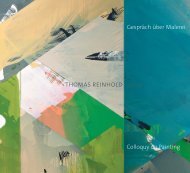You also want an ePaper? Increase the reach of your titles
YUMPU automatically turns print PDFs into web optimized ePapers that Google loves.
eveals itself and conceals itself at once, settles and thickens in layers, moves out of a mass and<br />
through fields sideways and vertically, as if holding, subduing and binding its centre together.<br />
At the same time, the picture thus obtained, read from the perpendicular view, turns towards<br />
the horizontals and embarks on a counter-movement. The dense darkness advances to the fore<br />
and then withdraws. On the right edge (seen from the standpoint of the picture), the colours are<br />
connected to the light, whereas on the left they form a contrast to the bright space, so that the<br />
symmetry rebounds as a kind of sound, with new rules, which opens up the view from the very<br />
back and encloses the brushwork in a painterly manner. In this way, the view is tilted away from<br />
the direction of the subject into the backlight of vision and becomes black on the blackness of<br />
the whole picture.<br />
Blackness is likewise embedded in lighter and grey tones, and strips develop rhythmically from<br />
the fields. The layering below is more generous and more contracted, condensed both inwardly<br />
and outwardly, forwards and backwards. Tapered to a translucent, even penetrative pyramidal<br />
point – and this at least twice, or even three times. Resourceful pathways cross: slow to fast,<br />
braking to driven. Opening up, but not entangled, provided with a counter-action, so that above<br />
and below, left and right, unfold not only alternatingly but also dynamically, inwards and outwards<br />
towards a restful viewpoint, developing into form and image. Formed to face the eye, to<br />
look eyewards.<br />
Thomas Reinhold, Skizze / sketch, 2018<br />
7<br />
The fact that, in the case of Thomas Reinhold, one can no longer speak of abstract art or painting<br />
in the usual sense is due to several reasons. [It would be nonsense to speak of representational,<br />
depictive-figurative art.] In the eye’s continuous encounter, in the constant step of the<br />
next view of colour and form, of shaping structure, self-revealing space, withdrawn surface and<br />
configuring view, the process as such is a characteristic part of the developing picture. That is<br />
also illustrated by his sketches. The process, although now not simply conceived as a part of the<br />
experience of the picture, which is simultaneously also an action, is rather a component of that<br />
which is both seeable and visible, so that the action is conceived both within the experience and<br />
emerging from it in the potential of the experience, and turns, so to speak, from the spontaneity<br />
of embraced sensuality to the receptivity of received sensuality.<br />
This addresses two points: 1. A realism which, according to its concept, does not adhere to depiction,<br />
but rather to process, to the processually conceived aspect of the picture; to the picture<br />
which can understand itself of its own accord, and can arise and comprehend itself within the<br />
other; to the processuality of the picture, which is creatively retrieved [through non-consumptive<br />
engagement] in the act of viewing, not through practical handiwork (of which only the artist<br />
is and would be aware), but rather through the characteristic, inscribed impressiveness of<br />
the picture’s expressions.



